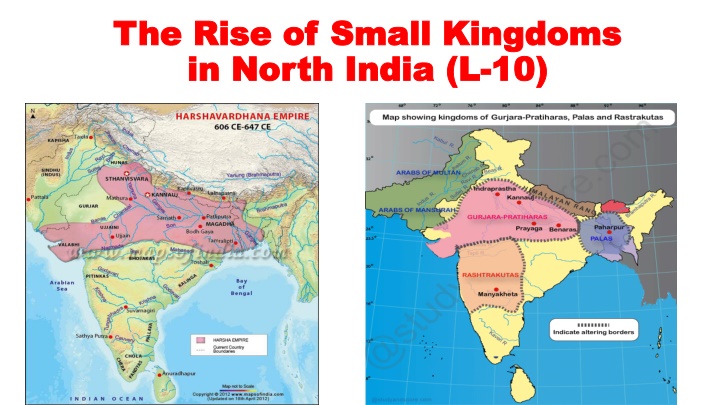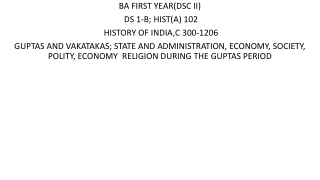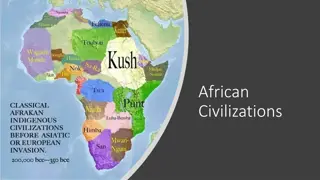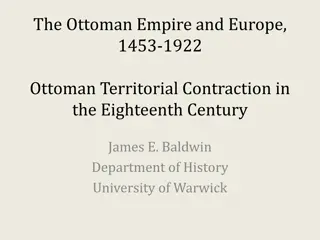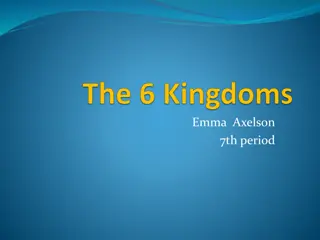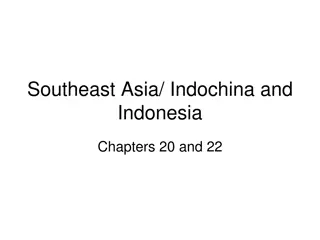Emergence of Small Kingdoms in North India During 8th to 10th Century
The rise of small kingdoms in North India between 750 CE to 1000 CE was a result of the disintegration of empires, economic struggles, and weak administration. This period saw the emergence of powerful kingdoms like the Rastrakutas, Palas, and Pratiharas in different regions of India, each contributing to art, architecture, literature, and religious patronage.
Download Presentation

Please find below an Image/Link to download the presentation.
The content on the website is provided AS IS for your information and personal use only. It may not be sold, licensed, or shared on other websites without obtaining consent from the author.If you encounter any issues during the download, it is possible that the publisher has removed the file from their server.
You are allowed to download the files provided on this website for personal or commercial use, subject to the condition that they are used lawfully. All files are the property of their respective owners.
The content on the website is provided AS IS for your information and personal use only. It may not be sold, licensed, or shared on other websites without obtaining consent from the author.
E N D
Presentation Transcript
The Rise of Small Kingdoms The Rise of Small Kingdoms in North India (L in North India (L- -10) 10)
Reason for emergence of new Empires. (Age of 3 Empires) 1) The whole empire disintegrated into small kingdoms. 2) There were miserable economic conditions. 3) There was lack of proper administration by weak successors. Hence powerful kingdoms rose up between 750 CE to 1000 CE. Rastrakutas Palas Pratiharas
Rastrakutas Rastrakutas 1) Location: The Rashtrakutas established the most powerful empire in Northern Deccan in 753 CE. They belong to the large area of present Gujarat, Madhya Pradesh, Bihar, Maharashtra and Karnataka. 2) Founder: Dantidurga Rulers: Govinda III & Amoghavarsha Titles: Maharajadhiraj, Chakravarti, Param Bhattarak 3)Administration: Had huge armies and encouraged trade for the prosperity of people. 4) Religion: Jainism but patronised other religion.
5) Art & Architecture: rock-cut temples of Ellora. 6) Literature: used Sanskrit eg- Kaviragamarga (kannada poetry) by Amoghvarsha
Palas Palas 1) Location: The Palas established the most powerful empire in Bengal which ruled for nearly 400 years. Very limited information is provided. 2) Founder: people elect Gopala as their King. Rulers: Dharampala & Devapala Titles: people used Pala after their name. 3) Religion: Buddhism but patronised other religion. 4) Importance: defeated Huns. Gave generous grants to Brahmins to build temples.
5) Art & Architecture: Buddhist education centre Vikramsheel Vihar. Nalanda University was revived during this period. 6) Literature: send scholars to different countries to preach Buddhism.
Pratiharas Pratiharas 1) Location: They are called Gurjara-Pratihara as they originated and ruled Gujarat and south-western Rajasthan. They belong to the large area of present Gujarat, Madhya Pradesh, Bihar, Maharashtra and Karnataka. 2) Founder: Nagabhatta-1 Rulers: Mihir Bhoj 3) Religion: Hinduism 4) Importance: stopped Arab invasions for 300 years.
5) Art & Architecture: Beautiful temples of Khjuraho, Kanchipuram, Thanjavur, Bhubaneshwar, Puri and Konark. 6) Literature: Marathi, Gujarati, Bengali, Assamese and Oriya.
The Tripartite Struggle for The Tripartite Struggle for Kannauj Kannauj During the 8th century AD, a struggle for control over the Kannauj took place among three major empires of India namely the Palas, the Pratiharas and the Rastrakutas. The struggle for control over Kannuj among these three dynasties is known as the Tripartite struggle in Indian history. The tripartite struggle thus started, lasted for two centuries and made all three dynasties weak in the long run. This resulted into the political disintegration of the country and benefited the Islamic invaders from Middle-east.
Rajputs Rajputs During 9thcent, north India became the patch work of small kingdoms as the power of three empires came to an end. During 10thcent, 3 major developments occur- 1. North India came in close contact with western India. 2. Most kingdoms came under the rule of Rajputs. 3. Continuous wars among the rulers create political instability and attracted Tuskish Invaders. Rajputs played a very important role in in this time period. There is no clarity about their origin.
Origin of Rajputs 1. The word Rajput means son of raja . But all rajputs do not belong to the Royal Family. 2. They trace their origin to sun or moon and thus, are known as Suryavanshi and Chandravanshi. 3. Some historians believe that they belong to the foreign tribe. 4. They also believed that they were born from fire altras and hence are known as Agnikuls.
Administration Administration 1. The King was the head of the State, military and judiciary. 2. His prime duty was to protect the people from internal disturbance and external attacks. 3. The rights of the kings were unlimited. 4. He had council of ministers which were headed by different officials. 5. The kingdoms was divided into different provinces which was headed by an official. 6. Central administration was divided into different departments.
Economy Economy 1. There was a great economic disparity among different social classes. 2. The royal family, high officials and the traders were prosperous. 3. The people living in villages were poor. 4. The temple were the centres of riches and hence, attracted a lot of invaders. 5. Feudal System was prevalent in North India. The king granted land as rewards to officers. KING - 6
Social Condition Social Condition 1. The rigid caste system led to the division of Indian society. 2. The King, the feudal lords and the brahmins in high positions enjoyed the life of luxury. 3. Land was cultivated mainly by Shudras who were burdened by taxes and social discrimination. 4. The condition of women was quiet miserable and they were deprived of education. 5. The evil practices of Sati pratha, child-marriage and polygamy contributed to the decline in the status of women.
Education Education 1) Superstitions and narrow-mindedness were a great hurdle to education. 2) The elementary education was limited to temples and monasteries. 3) The universities of Nalanda and Vikramsheel Vihar became important centres of higher education. 4) The study of philosophy and religion was encouraged but subjects like mathematics and science were ignored. 5) The regional languages like Marathi, Gujarati and Bengali developed but Sanskrit enjoyed a place of prominence.
Activity Activity Kingdoms of North India Kingdoms of North India DYNASTY FOUNDER RELIGION ART & ARCHITECTU RE ACHIEVEME NT Rastrakutas Palas Pratiharas
